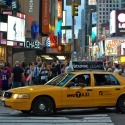January 29, 2016

Beneath the streets of Manhattan, a dark force is building in strength, spreading its reach and beginning to amass power.
Fortunately for the denizens of that great city, this is a dark fiber network, being built block by block by ZenFi , a carrier-neutral dark fiber network intended to power pervasive small cell deployments. The operation, which was launched in 2014 and began access network construction in earnest last year, is emblematic of the new edge networks, in that it supports edge computing and processing that puts colocation spaces deep into neighborhoods, and is much denser in terms of fiber access points. (See Metro Connect Bubbles With Optimism.)
"Our network is really for mobile processing, but it can support edge computing or edge caching," says Ray La Chance, president and CEO. He sees three key components to this new kind of network, only one of which exists pervasively today: backhaul into the core of the network.
What ZenFi is building is the fronthaul piece, aggregating the connections from the core to the antenna of the wireless network, establishing neighborhood colocation spots that become like mini data centers, capable of caching and processing data and content. These are placed similarly to telco central offices, and ZenFi plans four to six to start with in Manhattan and at least one in each of the other NYC boroughs.
Want to learn more about Gigabit Cities? Join us for Light Reading's second annual Gigabit Cities Live event taking place this year on April 5 in Charlotte, NC.
The company is then running very dense fiber connectivity out of those locations, with much more frequent access points on the fiber than exist in today's network, so it is capable of supporting widely distributed antenna locations -- literally one in every Manhattan intersection -- for pervasive wireless connectivity.
ZenFi will also have a mesh backhaul network connecting its colo sites for resiliency's sake, La Chance notes. The fronthaul pathway is non-redundant to start, but the company is trying where possible to create ring-like deployments to enable traffic rerouting if problems develop.
"We are trying to build everything in a ring, but it may not make sense where some [network] extremities are concerned, just not financially feasible," he explains.
Speaking of finances, all of this requires new approaches to fiber architecture and construction, so that access points to the fiber are much more available and the kind of dense network ZenFi plans can be built in a place like downtown Manhattan. ZenFi is deploying new methods, including microducts and airblown fiber, that were first developed in Asia for dense populations areas there. It also has close ties to Metro Network Services, which builds networks in the Northeast US, including the Lexent Metro Connect network -- where La Chance first operated -- that was later sold to Lightower.
Key to the process is driving down the cost of all the splice points required to have connections at every intersection. That's where ZenFi and its construction partner have focused their efforts, developing techniques that can be replicated to drop the typical fiber node cost from the $80,000 for a cell tower to one third of that for a DAS installation, La Chance says. He rents duct space from Verizon Communications Inc. (NYSE: VZ) subsidiary, Empire City Subway.
"We developed some really unique techniques for [splice points] so we could replicate them over and over," La Chance says. "We do have to use highly specialized labor but we use it more efficiently. Our construction partners are working with us on this. We have been building the backhaul networks for the last year and a half and the local network starting six months ago."
The company's four-year build plan will cover about 70% of intersections in Manhattan, but it isn't waiting to sign up carrier customers for its fiber network, who may want to just light up buildings at this point.
What La Chance envisions for Manhattan is something he is already seeing in some Asian cities, which is tall, shiny buildings with essentially a cell site on each floor and pervasive high-speed wireless that can begin to displace wired broadband for residents.
That's why a dense, very high-capacity dark fiber network, with all those access points, makes perfect sense to build, even at high cost.
— Carol Wilson, Editor-at-Large, Light Reading
You May Also Like









